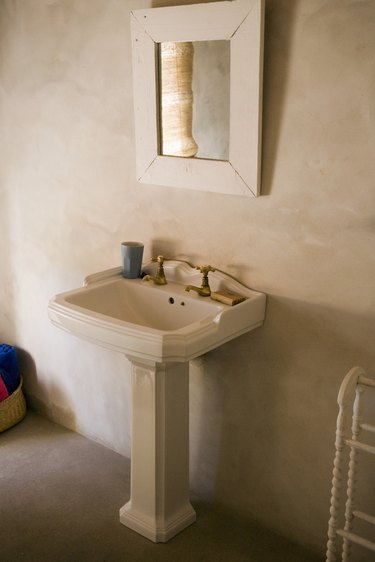Things You'll Need
2-by-4-inch blocking boards
Nails or screws
Hammer or screw gun
PVC pipe
Copper tubing
PVC cement
Fine sandpaper
Propane torch
Solder flux
Solder
Hacksaw
PVC P-trap
Water shutoff valves

A pedestal sink can be attractive, especially in a small bathroom that lacks space for a large vanity-style sink with a storage cabinet. Pedestal sinks often have elaborate and decorative bowls, but they all rest atop a column that conceals the water lines and drain pipe. The sink bowl typically is fastened to a wall. Preparing for installation of a pedestal sink involves "rough plumbing," which is running the basic water supply and drain lines to a place where they can be properly connected to the sink. If the sink is a replacement, that requires opening the wall to expose the studs.
Step 1
Install "blocking" between studs in the wall by mounting 2-by-4-inch boards between studs at the mounting height for the bowl; the sink will fasten to the blocking strips. Refer to instructions with the sink for this specific distance, which will vary among sinks. Nail or screw the blocking strips to the studs with a hammer or screw gun.
Video of the Day
Step 2
Check sink instructions for the height of the water supply and drain pipes. Use white polyvinyl chloride (PVC) pipe for the drain and copper pipes for water supply. Connect them to the main supply and drain lines in a basement or crawl space. Fasten PVC with PVC cement and cleaner: Swipe cleaner around the portions of the PVC fittings, then apply cement to both pieces of PVC, twist them together, hold them in place for a few seconds, and let the cement set. For copper, solder the tubing ends together: Clean both ends of tubing with fine sandpaper, spread flux on the pipes and slip them together. Heat the joint with a propane torch until the solder begins to melt, then run solder all around the seam.
Step 3
Run water supply lines about 2 inches past the face of the wall, through holes drilled into the wall covering. Extend the drain pipe horizontally a foot or so past the wall. Find the distance from the center of the sink drain to the wall and mark the distance on the PVC drain pipe. Hold a P-trap with an elbow centered on the mark and use a hacksaw to cut the drain pipe at that spot. Take care to make a square cut.
Step 4
Solder shutoff valves to the water supply lines coming out of the wall. Leave the ends open to connect water lines from the sink once it is set in place.
Step 5
Fasten the P-trap to the drain pipe with a compression connector on the trap; these have plastic or rubber washers that compress as a mounting nut is tightened, sealing the joint. Make sure the P-trap connection is level where it meets the drain pipe from the wall, and ensure that the vertical opening on the other end will connect properly with the sink drain.
Tip
P-traps and shutoff valves have covers that slide over the pipes to fit against the openings in the wall. Make sure these are in place properly before securing connections.
Warning
Check building codes before installing a sink. Some codes require that plumbing connections be made by licensed plumbers.
Video of the Day